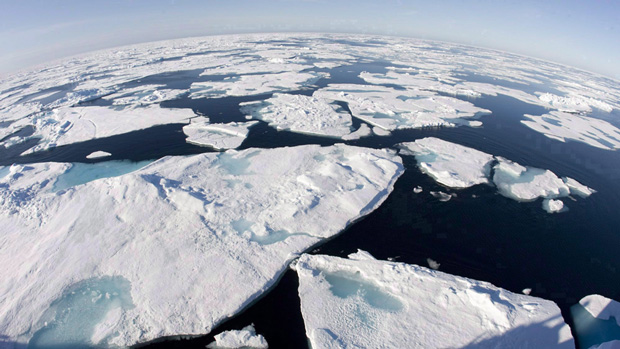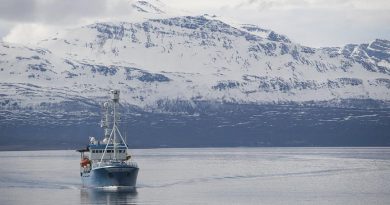Study finds increase in litter on Arctic seafloor
 Carbon dioxide, black soot, and nuclear waste are all commonly discussed pollutants in the Arctic.
Carbon dioxide, black soot, and nuclear waste are all commonly discussed pollutants in the Arctic.
The potential risk of contamination from oil spills is also another pollutant that receives a sizable amount of attention both in the media and in academia.
Yet a new study in Marine Pollution Bulletin discusses a pollutant that is quite low in terms of its visibility: marine litter on the deep seafloor.
To examine trends in Arctic seafloor debris, Melanie Bergmann and Michael Klages studied photos taken between 2002 and 2011 by the HAUSGARTEN observatory. The world’s only deep-sea long-term polar observatory, it consists of 16 permanent stations situated in the Fram Strait at 79°N, near Svalbard, at various depths. The photos were taken from the observatory that sits on the seafloor 2,500 meters (1.5 miles) below sea level. Over time, the researchers found that the amount of litter more than doubled, from 3635 to 7710 items km2, mostly plastic. Sadly, 67 percent of the litter was entangled by marine invertebrates like sponges and sea anemones.
As the authors point out, in 1988, the International Convention for the Prevention of Pollution from Ships’ (MARPOL) Annexe V, “Prevention of Pollution by Garbage from Ships,” banned “the disposal into the sea of all plastics, including but not limited to synthetic ropes, synthetic fishing nets and plastic garbage bags.” Despite this ban, however, ships seem to be dumping plastic in large quantities on the Arctic seafloor. Bergmann and Klages found that the amount of debris was similar to that in deep-sea canyons off the coast of Lisbon.
Source of Arctic debris?
This is quite shocking, given that the waters around Portugal are a much more shipping-congested area. The researchers believe that the increase in debris in the Arctic is likely due to the upsurge in shipping traffic, as after 2007, the number of research vessels and private yachts near Svalbard went up almost three times. However, the authors do not think that it is likely that research vessels are the source of the debris, as “most research vessels follow strict waste disposal rules.” Instead, they hypothesize that private yachts and fishing boats are likelier culprits of the Arctic seafloor debris. It is also posited that the trash may have been carried by the North Atlantic drift and the West Spitsbergen current. Finally, the loss of sea ice means that more ships are coming into the circumpolar north and more trash is making its way down to the seafloor, unimpeded by frozen water.
This past September, for instance, the Australian tycoon Paul McDonald took his luxury yacht, the MY Fortrus, on an Arctic cruise through parts of the Northwest Passage with a whole host of revelers onboard. The Royal Canadian Mounted Police fined him CAN $9,900 for violating local laws in Nunavut, including illegal possession of alcohol and fireworks. The amount of damage his ship inflected on the environment might be greater than that rather paltry fine, however. Of course, it is unclear whether he littered in the Arctic, but it is likely these types of ships, some of which are already engaging in arguably reckless behavior, that are responsible for some of the debris.
Enforcement
It is hard to enforce regulations in the wide open Arctic. Codes of conduct that vessels are supposed to follow, such as MARPOL, are only paper without enforcement. Additionally, as sea ice melts, the area into which ships can sail becomes wider, making it harder to patrol. The problem of seafloor debris epitomizes the tragedy of the commons. Ships would not dump trash in their own berths, but out in the deep blue of the open ocean, there are very few consequences for doing so. Seafloor trash also has the problem of being “out of sight, out of mind.” Whereas a struggling polar bear will surely make for a gripping photo, hardly any human will ever see a plastic bag on the ocean floor; even then, photos of sponges caught in plastic are admittedly not as heart-rending to the average person. Yet there are real consequences that go beyond the aesthetic, as Bergmann and Klages point out. Gas exchange can be negatively affected, invasive species such as certain types of barnacles can attach themselves to floating debris, and the presence of plastic in the ecosystem can possibly even increase the chances of cancer in species further up the food chain.
I’m not really sure what can be done to combat the problem of Arctic seafloor debris. Oran Young, the father of Arctic geopolitics and a scholar of international regime formation, described in his seminal 1989 article, “The Politics of International Regime Formation: Managing Natural Resources and the Environment,” six features likely to aid the creation of a multilateral agreement to tackle a problem. They are:
1.A “veil of uncertainty” that makes it unclear whether the parties involved will benefit or be harmed by the problem.
2.An equitable (rather than efficient) arrangement needs to be available.
3.Salient solutions increase the possibility of success in collective bargaining.
4.Clear-cut compliance mechanisms should be at the ready.
5.Exogenous shocks or crises are useful to stimulating successful collective bargaining.
6.Effective leadership greatly amplifies the chances of success.
Yet a multilateral agreement regarding seafloor debris has existed for well on twenty years. The real problem, then, is one of enforcement. Though the world’s countries came together to create MARPOL in the 1980s, the fourth issue Young points out — clear-cut compliance mechanisms — do not exist in the Arctic to prevent dumping. I sadly think that the problem will only increase as traffic in the Arctic continues.



Pingback: Canadian scientists fight to save key climate change science lab in High Arctic – Eye on the Arctic
Pingback: Canadian Coast Guard wraps up busy Arctic season – Eye on the Arctic
Pingback: Ottawa on thin ice over staff shortage at High Arctic weather station – Eye on the Arctic